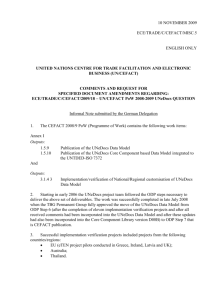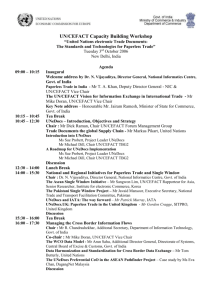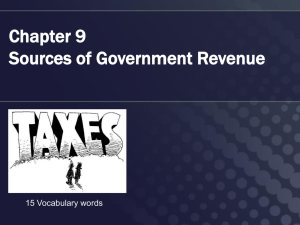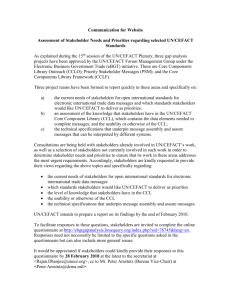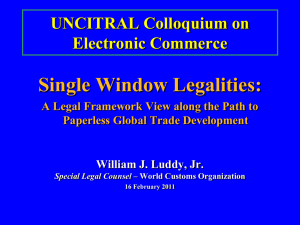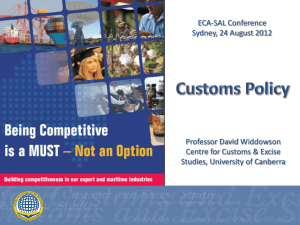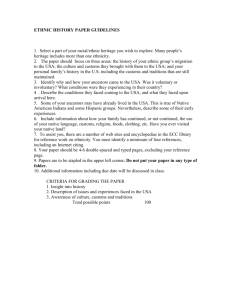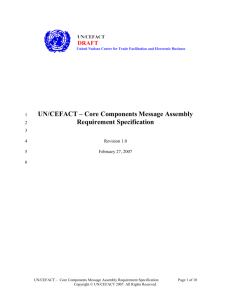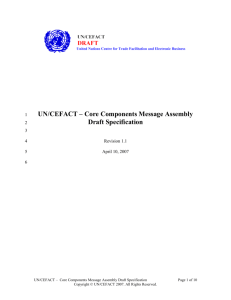ITAIDE Project
advertisement
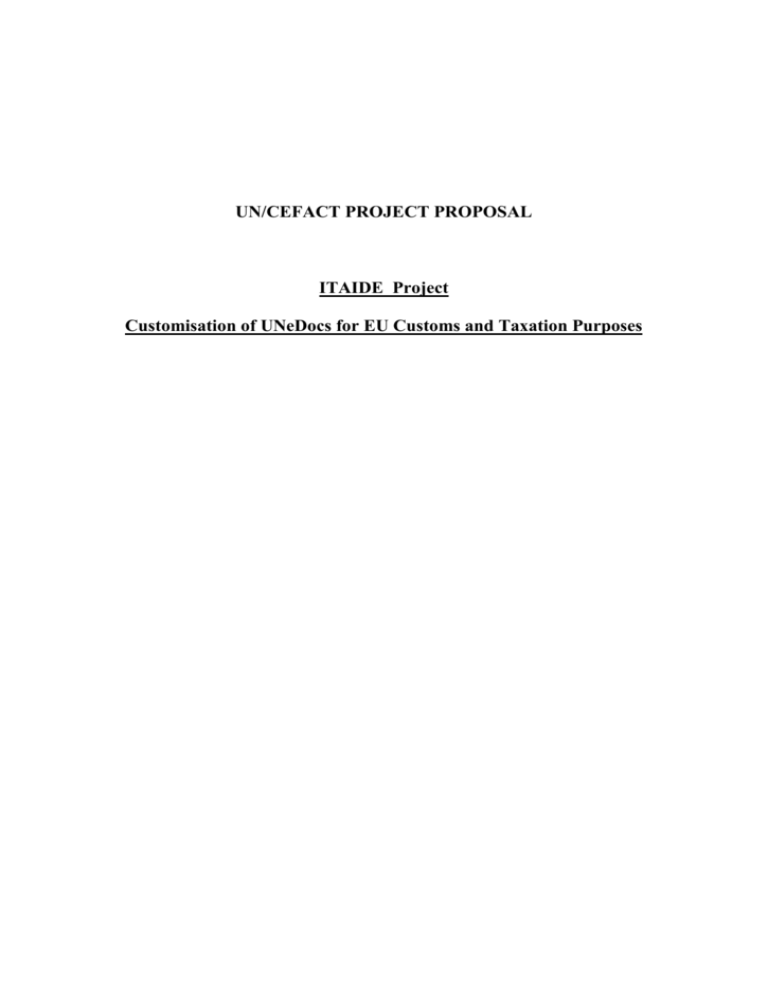
UN/CEFACT PROJECT PROPOSAL ITAIDE Project Customisation of UNeDocs for EU Customs and Taxation Purposes 1. OBJECTIVES The core objective of the UneDocs project is the development of a CCTS compliant data model which is aligned to the UNTDED (ISO 7372) and the scope of which is covered by the International Supply Chain Reference Model. From this syntax-neutral UNeDocs data model trade, transport, finance, insurance, customs and other regulatory authorities documents and their equivalent electronic forms can be derived. See document TRADE/CEFACT/2005/Vers. 0.4 16 March 2005 for full project proposal. The objective of the EU Research Project ITAIDE is to innovate the redesign of systems leading to a fundamental simplification of cross-border taxation and customs procedures, while providing greater control, security, transparency and accessibility to data for the needs of public administration, business and citizens in Europe. ITAIDE integrates and strengthens European research for innovative modern government by enhancing service offerings and disseminating good governance practice through increased security and controls, while commensurately employing intelligent ICT to reduce administrative load burden. This UN/CEFACT ITAIDE project proposal has the objective to develop a customised subset of the UNeDocs Data Model for the ITAIDE research project. This subset will be aligned with the WCO data Model and will provide for the derivation of CCTS compliant payloadsyntax neutral document structures to support the EU Customs and Taxation reporting requirements. The resultant model will also be used during the ITAIDE research project as the canonical model which will form the foundation for the document exchanges in case studies which will be conducted to demonstrate (1) that international standards can be reused to support Customs and Taxation requirements across the EU. (2) How best practices in e-custom procedure redesign can be transferred throughout Europe to support the development of the eAmber and eSilk roads. The ITAIDE subset Data Model which will be delivered from this UN/CEFACT project will finally provide the basis for the future technical framework from which all EU Customs and International Trade related Taxation document exchanges may be derived and published by TAXUD (EU Customs and Taxation Directorate). 1.1 Purpose To a) strengthen the traditional trade facilitation agenda within the EU by applying a holistic approach to trade and transport reporting documents, based on the coordination of Trade Facilitation and eBusiness layers and b) b) enable the development of simple low-cost solutions to support the generation and exchange of standardised paper and/or electronic Customs and Taxation reporting documents by implementing existing international standards and recommendations. 2 1.2 Scope The scope of the project will be to develop a customisation of the UNeDocs CCTS compliant data model to cover the EU Customs and international trade related Taxation reporting regimes. The scope will include alignment to the WCO Data Model, to the UNTDED and to the UN/CEFACT Core Component Library standards. The project will also include the derivation of payload-syntax neutral document structures and UN/CEFACT conformant XML schemata. This project can only be achieved by means of a close co-operation between trade, transport, customs and taxation authorities document users. 2. DELIVERABLES A set of deliverables will be developed for the production of paper and digital EU Customs and Taxation reporting document specifications comprising: A UNeDocs compliant subset Data Model based on UN/CEFACT Core Components linked to the UNTDED/ISO 7372 and showing the relationships between key Business Entities referred to across the EU Customs and Taxation reporting documentary requirements. BRSs and RSMs submitted from the ITAIDE case studies. In the absence of an existing BRS or RSM the processes will be modelled against existing EU Customs and Taxation (TAXUD) published regulatory requirements. For each document the project will also develop: o A structure class diagram o Where applicable the layout of the document based on the UN Layout Key o Where applicable a set of Box Completion Guidelines o XML specifications (i.e. UN/CEFACT schema, stylesheet) o Where applicable a UN/EDIFACT message implementation guide 3. FUNCTIONAL EXPERTISE OF MEMBERSHIP The implementation of UNeDocs documentary requirements by e-business experts also requires resources, expertise and inputs from the relevant Working Groups of the TBG Permanent Group of the UN/CEFACT Forum in particular the UNeDocs project team, TBG1, TBG3 and TBG4, TBG19 and TBG15. This project also requires strong collaboration with the TAXUD Customs and Taxation Directorate of the EU and with the WCO (World Customs Organisation). Further research should be undertaken to identify other organisations, internal and external to the UN that could provide valuable contributions to the strategic direction and tactical work programme of the project. All participating experts are expected to contribute to the work based solely on their expertise and to comply with the UN/CEFACT Code of Ethics. 4. GEOGRAPHICAL FOCUS 3 The focus is EU regional Customs and International Trade related Taxation reporting regulatory requirements. 5. INITIAL INPUTS All UNeDocs project deliverables and artefacts to date UN/CEFACT International Trade Reference Model UNTDED (ISO 7372 2004 version) CCTS (ISO 15000 Part 5) and the UN/CEFACT Core Component Library UNECE Recommendations, particularly Rec. 1 (UNLK) UNTDID and UN/CEFACT XML Naming and Design Rules Existing developments of relevant UN/CEFACT TBG WGs. 6. STATEMENT OF RESOURCE REQUIREMENTS UNECE, SITPRO and the UN/CEFACT UneDocs Project Team plus other supporting organizations have already invested significant resources and expertise into the development of UNeDocs to date. The effective reuse of UNeDocs to provide a canonical Data Model which can provide the document exchange framework for the EU Customs and International Trade related Taxation reporting regulatory requirements is dependent on the organization of a maintenance and publication process, commitments and allocation of resources to deliver the next phases of the project according to an agreed work plan. The team which will lead the ITAIDE project consists of: Project Team Leads – Jörg Walther, GEFEG Editor – Sue Probert, Sepia Technical Team – the ITAIDE WP1 Project Team 4 5
